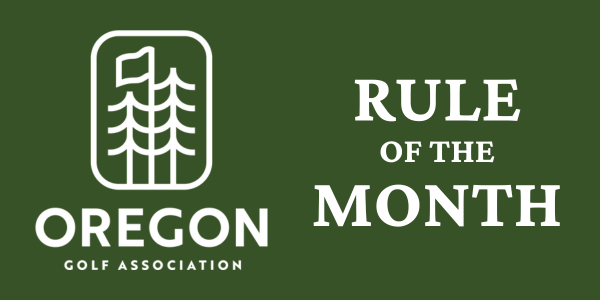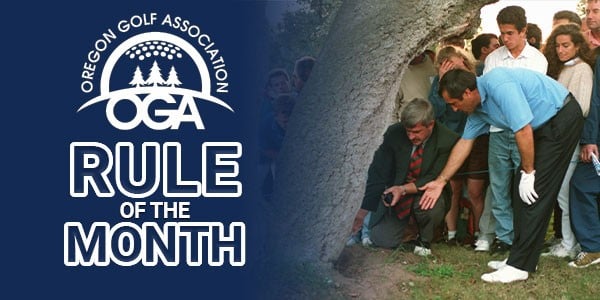Review of Rule 14. Congratulations! With the completion of this article, you have made it to the end of Rule 14.
We have spent 11 months focusing on this very important Rule, one that is referenced in almost every Rule in the book. By the time you complete this month’s quiz, you will have answered 110 questions on the subject. It is a complicated Rule to learn and understand, but is a catalyst to understanding other Rules.
We wrap up this series with a review of the past 10 months. Test your knowledge on Rule 14 with the following questions.
Questions: True / False
1) A player’s ball has come to rest against a rake in the bunker. When the player lifts the rake, the ball moves. The player is required to replace the ball on the spot and must not clean the ball.
2) When a player replaces a moved or lifted ball in the general area, bunker or penalty area, they are not allowed to line up the trademark or a line on the ball with the direction of play. That action is only allowed on the putting green.
3) After dropping a ball when taking free relief from interference by a cart path in the general area, if the player makes a stroke with their heels touching the path, they have played from a wrong place.
4) If the lie of a moved ball that must be replaced is altered, the player must recreate the lie if the ball was in sand.
5) To replace a ball properly, it must be set down by hand on the required spot and must not be replaced using any other method, such as rolling it to the spot.
6) When taking free relief from a cart path, the original ball must be used, unless it is not immediately retrievable.
7) When dropping a ball under a Rule, the ball must be dropped from above knee height.
8) Once a stroke is made at the ball within the relief area, it is too late to correct an improper place or drop.
9) The error of playing from a wrong place must always be corrected.
10) When making the next stroke from where the previous stroke was made, a ball must be dropped. This applies to every area of the course except the putting green where it must be placed.
---
Answers:
1) False. Clarification 14.1c/2. When a player lifts a ball to replace it on a spot, it may be cleaned. There are only four times when a lifted ball may not be cleaned: 1) to see if it is cut or cracked, 2) to identify it, 3) because it interferes with play, 4) to see if it lies in a condition where relief is allowed.
2) False. Clarification 14.2c/1. The ball may be aligned in any way when replacing it anywhere on the course. The Rules are only concerned about the location of the ball. And remember, vertical distance to the ground is included in the location of the ball and must be the same as when the ball was lifted or moved. In other words, no “teeing” it up on a tuft of grass if it wasn’t there before being moved or lifted.
3) True. Clarification 14.7b/2. When taking free relief from an immovable obstruction, complete relief is required. In this situation, the relief might have been free but if the player makes a stroke with his or her feet touching the path, they incur the general penalty for playing from a wrong place.
4) True. Rule 14.2d(1). This applies to sand everywhere on the course and not just the bunkers. If the ball had been covered with sand, the player may leave a small part of the ball visible when recreating the lie. Truly a gift from the Rule writers.
5) True. Rule 14.2b(2). This Rule specifically instructs how the ball must be replaced by setting it down by hand on the required spot and letting it go so that it stays on that spot. To do otherwise, such as rolling it to the spot, gets the player one penalty stroke for the improper replacing.
6) False. Rule 14.3a. Each time a player drops or places a ball under a Rule, they may use any ball. But take note, if the Rules require that a ball is to be replaced, the original ball must be used, unless it is not immediately retrievable.
7) False. Rule 14.3b(2). The ball must be dropped from knee height and must not touch the player or equipment before it hits the ground. A ball dropped in a wrong way may be lifted and the player may drop that ball or another ball correctly. If the player fails to correct the improper drop and plays the ball, they get one penalty stroke if the ball came to rest in the correct relief area, or two penalty strokes if it was outside the relief area.
8) True. Rule 14.5a. Correction of the error of an improper place or drop must be done before a stroke is made at the ball. Failure to do so gets the player one penalty stroke for the improper placement or drop.
9) False. Rule 14.7. This is false in two ways. First, the error of playing from a wrong place in match play is not corrected since the player losses the hole as soon as a stroke from the wrong place is made. Second, in stroke play, only a serious breach of playing from a wrong place needs to be corrected. If the breach is not serious, the player must continue with the ball played from the wrong place and add two penalty strokes to their score. Please note that if a correction is made, the player still incurs the two-stroke penalty for playing the original ball from a wrong place.
10) False. Rule 14.6. When making the next stroke from where the previous stroke was made in the general area, a penalty area or a bunker, the ball must be dropped. And on the putting green it must be placed. However, when making the next stroke from the teeing area, a ball may be dropped, placed or teed anywhere in the teeing area.


